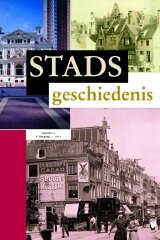Stadsgeschiedenis editie 2011 - 2

| Joris Vandendriessche Jelena Dobbels Jorg Amende Miriam van de Kamp (Review) Jan Hein Furnée en Tim Verlaan (Interview) Ed Taverne, Paul Knevel en Sebastian Dembski |
Abstracts
Joris Vandendriessche, Medical expertise and political struggles. Medical supervision of public schools in Antwerp, 1860-1900
This article uses the Antwerp service of medical supervision of public schools as a case-study of the interaction between physicians and politicians in Antwerp. From the 1860s onwards, Antwerp physicians developed a hygienist program of health reforms, including on school hygiene. The reception of their program in liberal political circles was multifold because of different opinions on government intervention. The specific organization of the service therefore showed how the hygienist program was negotiated between conservative and progressive liberal fractions and was intended to highlight the modern character of urban public education during the School War of the 1880s. In the political struggles of the 1890s, however, the image of an exemplary service came under pressure, showing the limits of the political uses of medical expertise.
Jelena Dobbels, Towards a heritage policy. The demolition of the Antwerp ‘Burcht’ as a casestudy for the changing attitude towards heritage (1863-1900)
This article offers a closer look on the nineteenth-century ‘paradoxical’ handling of the past: demolition next to preservation. As a result of enormous infrastructure works, great parts of the old European town centers were demolished. On the other hand a conservative vision arose that pleaded for town renewal with respect for the historical heritage. In the literature Belgium is seen as an example of the top-down model, because of the fast institutionalization of heritage conservation through the creation of the Royal Commission for Monuments in 1835. However, this article argues that the importance of the local and regional level has been underestimated in studies of emerging heritage conservation. The main focus of this article is the local level, more specifically the functioning of the supervision commission (1882-1885), which decided on the preservation of relicts from the citadel area that had to be demolished in the period of the redrawing of the river Scheldt. A study of the preservation arguments used by this commission offers insight in its policy vision. The resemblance between these urban lines of policy and the provincial, national and even international visions becomes clear. This study of the urban supervision commission intents to offer an alternative view on the (inter)national story of the rise of a nineteenth-century monument care.
Jorg Amende, A modern iconoclasm. Outdoor advertising and the struggle for the public space of Amsterdam, 1870-1930
In the course of the years 1870-1930 an advertising explosion erupted in Amsterdam. Outdoor advertising was everywhere and increasingly determined the urban landscape. The aim of this article is to show how entrepreneurs, heritage-organisations and the local government struggled for the city’s countenance. Although initially the local government only tried to regulate outdoor advertising on municipal property, heritage-organisations such as the Bond Heemschut increasingly succeeded to convince the municipality to severely restrict the presence of ‘un-aesthetic’ advertisements throughout the city. As the first systematic study on late-nineteenth and early-twentieth-century outdoor advertising in the Netherlands, this article contributes to divergent disciplines such as business history, history of advertising, heritage studies, visual culture studies and urban history